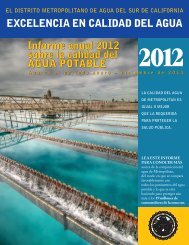Orange County Basin - Metropolitan Water District of Southern ...
Orange County Basin - Metropolitan Water District of Southern ...
Orange County Basin - Metropolitan Water District of Southern ...
You also want an ePaper? Increase the reach of your titles
YUMPU automatically turns print PDFs into web optimized ePapers that Google loves.
Chapter IV – Groundwater <strong>Basin</strong> Reports<br />
<strong>Orange</strong> <strong>County</strong> <strong>Basin</strong>s<br />
SOUTHWEST<br />
ELEVATION (FEET MEAN SEA LEVEL)<br />
200<br />
-200<br />
-400<br />
-600<br />
-800<br />
-1000<br />
-1200<br />
-1400<br />
-1600<br />
-1800<br />
-2000<br />
-2200<br />
-2400<br />
-2600<br />
-2800<br />
-3000<br />
A<br />
PACIFIC OCEAN<br />
0<br />
Figure 10-2<br />
Hydrogeologic Cross Section <strong>of</strong> the <strong>Orange</strong> <strong>County</strong> <strong>Basin</strong><br />
HUNTINGTON BEACH<br />
Talbert<br />
Barrier<br />
NEWPORT-INGLEWOOD<br />
FAULT ZONE<br />
FOUNTAIN VALLEY<br />
SANTA ANA<br />
EXPLANATION<br />
SILTS, CLAYS<br />
BURRIS PIT<br />
PERCOLATION BASIN<br />
SANDS, GRAVELS<br />
COLORED WATER<br />
CONSOLIDATED,<br />
NON-WATERBEARING<br />
FORMATIONS<br />
WATER TABLE<br />
OCWD AQUIFER RECHARGE AREA<br />
ANAHEIM<br />
CONROCK AND WARNER<br />
PERCOLATION BASINS<br />
NORTHEAST<br />
FINAL IV-10-4 September 2007<br />
SEA WATER<br />
A<br />
A'<br />
A'<br />
SANTA ANA RIVER<br />
The Upper aquifer system, which averages approximately 200 feet in thickness, consists <strong>of</strong><br />
alluvial sediments and includes the Talbert aquifer and recent alluvium. The total storage <strong>of</strong> this<br />
aquifer system is estimated to be approximately five million AF (OCWD, 2004). However, only<br />
about five percent <strong>of</strong> the total basin production comes from this aquifer because <strong>of</strong> lower<br />
production rates and poorer water quality than the underlying aquifers.<br />
The Principal aquifer system averages approximately 1,000 feet in thickness and is the primary<br />
source <strong>of</strong> production in the <strong>Orange</strong> <strong>County</strong> <strong>Basin</strong>. The principal aquifers are located<br />
approximately 200 to 1,200 feet below ground surface (fbgs). This aquifer is correlative with<br />
portions <strong>of</strong> the Lakewood Formation and the San Pedro Formation <strong>of</strong> the Central and West Coast<br />
<strong>Basin</strong>s in Los Angeles <strong>County</strong>. <strong>Orange</strong> <strong>County</strong> <strong>Water</strong> <strong>District</strong> (OCWD) estimates the total<br />
storage in this aquifer system is approximately 32.9 million AF (OCWD, 2004).<br />
Deeper aquifers below the principal aquifer system comprise the Lower aquifer system (DWR,<br />
2004), with a thickness <strong>of</strong> about 300 to 1,000 feet. Few wells produce from this aquifer because<br />
<strong>of</strong> the increased depth and the potential presence <strong>of</strong> colored water.<br />
The total estimated volume <strong>of</strong> fresh groundwater capable <strong>of</strong> being stored in the <strong>Orange</strong> <strong>County</strong><br />
<strong>Basin</strong> when it is completely full is estimated to be approximately 66 MAF by OCWD (2004).<br />
Based upon review <strong>of</strong> historical data, OCWD has established basin water contour levels, which<br />
represent a full basin. Volume in storage indicates how much storage space is available for use<br />
(defined as accumulated overdraft) within the <strong>Orange</strong> <strong>County</strong> <strong>Basin</strong>. OCWD estimates that<br />
between 400,000 and 500,000 AF <strong>of</strong> the total basin storage is actually usable (OCWD, 2004) in<br />
terms <strong>of</strong> emptying and filling operations. If groundwater levels are allowed to drop below the




